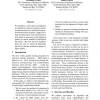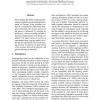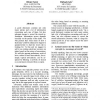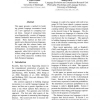ACL
2006
14 years 28 days ago
2006
We introduce a semi-supervised approach to training for statistical machine translation that alternates the traditional Expectation Maximization step that is applied on a large tr...
ACL
2006
14 years 28 days ago
2006
To study PP attachment disambiguation as a benchmark for empirical methods in natural language processing it has often been reduced to a binary decision problem (between verb or n...
ACL
2006
14 years 28 days ago
2006
In this paper we investigate the benefit of stochastic predictor components for the parsing quality which can be obtained with a rule-based dependency grammar. By including a chun...
ACL
2006
14 years 28 days ago
2006
We investigate the utility of supertag information for guiding an existing dependency parser of German. Using weighted constraints to integrate the additionally available informat...
ACL
2006
14 years 28 days ago
2006
As natural language understanding research advances towards deeper knowledge modeling, the tasks become more and more complex: we are interested in more nuanced word characteristi...
ACL
2006
14 years 28 days ago
2006
ACL
2006
14 years 28 days ago
2006
A good dictionary contains not only many entries and a lot of information concerning each one of them, but also adequate means to reveal the stored information. Information access...
ACL
2006
14 years 28 days ago
2006
Unification grammars are widely accepted as an expressive means for describing the structure of natural languages. In general, the recognition problem is undecidable for unificati...
ACL
2006
14 years 28 days ago
2006
Using abundant Web resources to mine Chinese term translations can be applied in many fields such as reading/writing assistant, machine translation and crosslanguage information r...
ACL
2006
14 years 28 days ago
2006
This paper presents a method for building genetic language taxonomies based on a new approach to comparing lexical forms. Instead of comparing forms cross-linguistically, a matrix...




